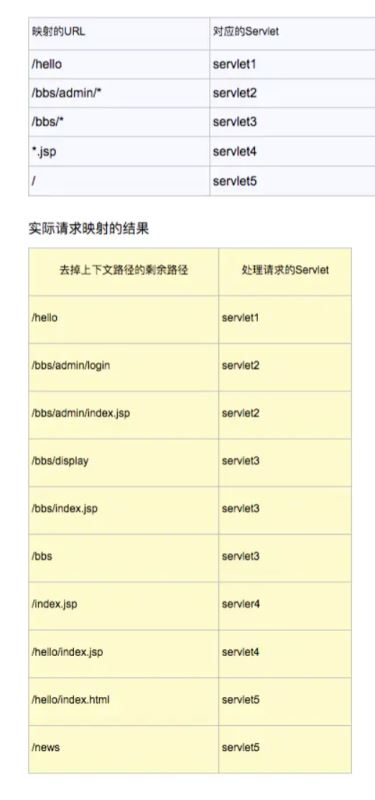您好,登錄后才能下訂單哦!
您好,登錄后才能下訂單哦!
這篇文章主要講解了解決tomcat關于配置servlet的url-pattern的問題,內容清晰明了,對此有興趣的小伙伴可以學習一下,相信大家閱讀完之后會有幫助。
tomcat在配置web.xml的時候,servlet是一個比較重要的問題,在這里討論一下servlet中的幾個痛點
/ 和 /* 的區別/ 的匹配問題1 servlet url-pattern 的匹配問題
url-pattern 有三種匹配模式,分別是路徑匹配、精確匹配、后綴匹配
1.1 精確匹配
<url-pattern> 中配置的項必須與url完全精確匹配。
代碼舉例:point_down:
<servlet-mapping> <servlet-name>MyServlet</servlet-name> <url-pattern>/kata/detail.html</url-pattern> <url-pattern>/demo.html</url-pattern> <url-pattern>/table</url-pattern> </servlet-mapping>
當在瀏覽器中輸入如下幾種url時,都會被匹配到該servlet
http://10.43.11.143/myapp/kata/detail.html http://10.43.11.143/myapp/demo.html
http://10.43.11.143/myapp/table
注意:
http://10.43.11.143/myapp/table/ 是非法的url,不會被當作 http://10.43.11.143/myapp/table 識別
另外上述url后面可以跟任意的查詢條件,都會被匹配,如
http://10.43.11.143/myapp/table?hello 這個請求就會被匹配到MyServlet。
1.2 路徑匹配
以“/”字符開頭,并以“/*”結尾的字符串用于路徑匹配
代碼舉例:point_down:
<servlet-mapping> <servlet-name>MyServlet</servlet-name> <url-pattern>*.jsp</url-pattern> <url-pattern>*.action</url-pattern> </servlet-mapping>
路徑以/user/開始,后面的路徑可以任意。比如下面的url都會被匹配。
http://localhost:8080/appDemo/user/users.html
http://localhost:8080/appDemo/user/addUser.action
http://localhost:8080/appDemo/user/updateUser.actionl
1.3 后綴匹配
以“*.”開頭的字符串被用于后綴匹配
代碼舉例:point_down:
<servlet-mapping> <servlet-name>MyServlet</servlet-name> <url-pattern>*.jsp</url-pattern> <url-pattern>*.action</url-pattern> </servlet-mapping>
則任何擴展名為jsp或action的url請求都會匹配,比如下面的url都會被匹配
http://localhost:8080/appDemo/user/users.jsp
http://localhost:8080/appDemo/toHome.action
注意:路徑和后綴匹配無法同時設置
注意:路徑和擴展名匹配無法同時設置,比如下面的三個都是非法的,如果設置,啟動tomcat服務器會報錯。
<url-pattern>/kata/*.jsp</url-pattern>
<url-pattern>/*.jsp</url-pattern>
<url-pattern>he*.jsp</url-pattern>
幾個實例:point_down:,不明白請看本文第三章

2 url-pattern中 / 和 /* 的區別
<url-pattern>/</url-pattern>
<url-pattern>/*</url-pattern>
先說 /* , /* 相對來講比較好理解,它是路徑匹配的一種,從范圍上來講,它是范圍最廣的路徑匹配,所有的請求都符合它的要求,從精度上來講,它是精度最低的路徑匹配( 注意!我說的是路徑匹配 ),路徑匹配的優先級是從長到短的( 具體請看本文第三章 ),所以說它是精度最低的路徑匹配。很多博客中說它的特點是匹配 *.jsp ,這不是廢話嗎? /* 本身就是路徑匹配,它當然可以匹配 *.jsp 。
再說 / , / 是匹配優先級最低的匹配 ,當一個url和所有的 url-pattern 匹配都不合適的時候,這個url就會走 / 匹配,根本就沒有什么 *.jsp 的限制,大家之所以產生了(客觀上也確實是這樣) / 不會匹配 *.jsp 但是 /* 會匹配 *.jsp 的原因是在tomcat/conf/web.xml里面單獨配置了 *.jsp 的配置, 具體請看本文第三章
3 url-pattern的優先級問題
當一個url與多個servlet的匹配規則可以匹配時,則按照 “ 精確路徑 > 最長路徑>后綴匹配”這樣的優先級匹配到對應的servlet。

例1:比如servletA 的url-pattern為 /test,servletB的url-pattern為 /* ,這個時候,如果我訪問的url為http://localhost/test ,這個時候容器就會先進行精確路徑匹配,發現/test正好被servletA精確匹配,那么就去調用servletA,不會去管servletB。
例2:比如servletA的url-pattern為/test/ ,而servletB的url-pattern為/test/a/ ,此時訪問http://localhost/test/a時,容器會選擇路徑最長的servlet來匹配,也就是這里的servletB。
例3: 比如servletA的url-pattern:*.action ,servletB的url-pattern為 / * ,這個時候,如果我訪問的url為http://localhost/test.action,這個時候容器就會優先進行路徑匹配,而不是去匹配擴展名,這樣就去調用servletB。

那么就產生了一個疑問。為什么 /* 會匹配到 *.jsp ,但是/匹配不到 *.jsp 呢
原因很簡單,在tomcat/conf/web.xml里面會有如下配置
<servlet-mapping> <servlet-name>default</servlet-name> <url-pattern>/</url-pattern> </servlet-mapping> <!-- The mappings for the JSP servlet --> <servlet-mapping> <servlet-name>jsp</servlet-name> <url-pattern>*.jsp</url-pattern> <url-pattern>*.jspx</url-pattern> </servlet-mapping>
:point_up_2:可以清楚地看到 *.jsp 作為名為jsp的servlet的后綴匹配,/*是路徑匹配,其優先級高于后綴匹配,所以能匹配到后綴為jsp的文件。而 / 是級別最低的匹配,其級別低于后綴匹配,所以jsp文件不會被 url-pattern 為/的匹配到。
4 根路徑 / 的匹配問題
大家應該會注意到一個問題,就是當url-pattern為/*的時候訪問http://localhost:8080/會404,但是訪問http://localhost:8080/index.html卻沒有問題(當然前提是在spring容器里面配置了 <mvc:default-servlet-handler/> )。當url-pattern為/時, http://localhost:8080/ 會自動轉發到 http://localhost:8080/index.html 而不會404。原因是什么呢?
首先,我們必須要明確,一個網址的根目錄即/(比如http://localhost:8080/)到底意味著什么?經過實驗發現/是很特殊的,它會被url-pattern為/*的匹配,但他不會被url-pattern為/匹配。
在tomcat中,/默認是屬于會被defaultservlet匹配,但是其優先級低于路徑匹配,所以當某一個servlet的url-pattern為/*時,/就會被這個servlet匹配,從而不被defaultservlet匹配。
在tomcat源代碼中找到如下片段可以佐證我的看法:point_down:
<!-- ==================== Default Welcome File List ===================== -->
<!-- When a request URI refers to a directory, the default servlet looks -->
<!-- for a "welcome file" within that directory and, if present, to the -->
<!-- corresponding resource URI for display. -->
<!-- If no welcome files are present, the default servlet either serves a -->
<!-- directory listing (see default servlet configuration on how to -->
<!-- customize) or returns a 404 status, depending on the value of the -->
<!-- listings setting. -->
<!-- -->
<!-- If you define welcome files in your own application's web.xml -->
<!-- deployment descriptor, that list *replaces* the list configured -->
<!-- here, so be sure to include any of the default values that you wish -->
<!-- to use within your application.
:point_up_2:上面是講 Welcome File List 的,即 / 路徑會被默認轉發到 Welcome File List 中規定的網頁,即初始頁。我翻譯一下上面的一部分,具體的可以谷歌翻譯,翻譯:point_right:
翻譯:point_down:
當請求URI指向目錄時,默認servlet在該目錄中查找“歡迎文件”,如果存在,則在相應的資源URI中查找以進行顯示。如果不存在歡迎文件,則默認servlet會提供目錄列表(請參閱默認servlet配置中的有關如何自定義的內容)或返回404狀態,具體取決于列表設置的值
/會重定向到歡迎頁面的原因是 Welcome File List 的存在, Welcome File List 發揮效果的前提是/必須被defaultservlet匹配。當某一個servlet的url-pattern為/*時,/就會被這個servlet匹配,從而不被defaultservlet匹配。所以只有在自己定義的servlet的url-pattern為/時, http://localhost:8080/ 會自動轉發到 http://localhost:8080/index.html 而不會404
看完上述內容,是不是對解決tomcat關于配置servlet的url-pattern的問題有進一步的了解,如果還想學習更多內容,歡迎關注億速云行業資訊頻道。
免責聲明:本站發布的內容(圖片、視頻和文字)以原創、轉載和分享為主,文章觀點不代表本網站立場,如果涉及侵權請聯系站長郵箱:is@yisu.com進行舉報,并提供相關證據,一經查實,將立刻刪除涉嫌侵權內容。